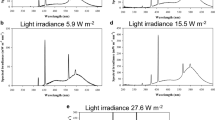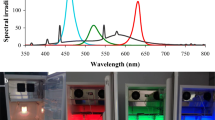Abstract
The determination of the ideal cultivation conditions and the knowledge of solar radiation tolerance are important aspects that must be investigated for the use of Bipolaris euphorbiae Muchovej and Carvalho as a biocontrol agent. The present study was done to assess the growth rate, sporulation and viability of the fungus cultivated under different conditions of the initial pH value of the growth medium, temperature and photoperiod. The tolerance of this fungus’ conidia to light from a source simulating solar and ultraviolet radiation was also assessed. B. euphorbiae was affected by different pH values of the growth medium being 6.0 the adequate pH for fungus cultivation. Incubation of the fungus under temperatures of 22, 25 and 28°C enhanced mycelium growth, while sporulation and viability of conidia were better at 22 and 16°C. Different regimens of exposure to light of fungal cultures only affect sporulation. Conidia exposed to solar and ultraviolet radiation for 8 h and 90 min, respectively, presented viabilities higher than 92%, indicating high tolerance levels to radiation exposure.



Similar content being viewed by others
References
Babitha S, Carvalho JC, Soccol CR et al (2008) Effect of light on growth, pigment production and culture morphology of Monascus purpureus in solid-state fermentation. World J Microbiol Biotechnol 24:2671–2675
Barbosa AM, Souza CMG, Dekker RFH et al (2002) Phytotoxin produced by Bipolaris euphorbiae in vitro is effective against the weed Euphorbiae heterophylla. Braz Arch Biol Technol 45:233–240
Barreto RW, Evans H (1998) Fungal pathogens of Euphorbiae heterophylla and E hirta in Brazil and their potential as weed biocontrol agents. Mycopathol 141:21–36
Braga GUL, Flint SD, Rangel DEN et al. (2002) Damage to fungi from solar UV exposure and genetic and molecular biology approaches to mitigation. In: Proceedings of the international colloquium on inset pathology and microbial control, 1ed EMBRAPA/Soja, Londrina, pp 241–245
Braga GUL, Rangel DEN, Flint SD et al (2006) Conidial pigmentation is important to tolerance against solar-simulated radiation in the entomopathogenic fungus Metarhizium anisopliae. J Photochem Photobiol 82:418–422
Carlile MJ, Watkinson SC, Gooday GH (2001) The fungi, 2nd edn. Academic Press, San Diego
Charudattan R (1993) Controle biológico de plantas daninhas através de fitopatógenos. Funep-Unesp, Jaboticabal
Christoffoletti PJ, Vitória Filho R, Silva CB (1994) Resistência de plantas daninhas aos herbicidas. Planta Daninha 12:13–20
Francisco EA, Rangel DEN, Junior NLS et al (2008) Exposure of Metarhizium anisopliae conidia to UV-B radiation reduces its virulence. J Anhui Agric Univ 35:246–249
Gazziero DLP, Yorinori JT (1993) Experiências sobre o controle biológico de Euphorbiae heterophylla no Brasil. Funep-Unesp, Jaboticabal
Gazziero DLP, Calçavara PR, Yorinori JT et al. (1989) Efeitos da luminosidade na germinação de esporos de Helminthosporium sp. In: Resultados de pesquisa de soja, 1ed EMBRAPA/Soja, Londrina, pp 275–278
Jackson AM, Whipps JM, Lynch JM (1991) Effects of temperature, pH and water potential on growth of four fungi with disease biocontrol potential. World J Microbiol Biotechnol 7:494–501
Kang H, Park Y, Seung J (2003) Growth inhibition of a phytopathogenic fungus, Colletotrichum species by acetic acid. Microbiol Res 158:321–326
Langfelder K, Streibel M, Jahn B, Haase G et al (2003) Biosynthesis of fungal melanins and their importance for human pathogenic fungi. Fungal Genet Biol 38:143–158
Lilly VG, Barnett HL (1951) Physiology of the fungi. MacGraw-Hill Book, New York
Lorenzi HJ (2000) Plantas daninhas do Brasil: terrestres, aquáticas, parasitas, tóxicas e medicinais. Nova Odessa, São Paulo
Nechet KL, Barreto RW, Mizubuti ESG (2006) Bipolaris euphorbiae as a biological control agent for wild poinsettia (Euphorbiae heterophylla): host-specificity and variability in pathogen and host populations. Biocontrol 51:259–275
Penariol MC, Monteiro AC, Pitelli RA (2008) Crescimento e esporulação de Bipolaris euphorbiae cultivado sob diferentes condições nutricionais. Cienc Rural 38:1907–1913
Pitelli RA (1991) Weed-soybean interference studies in Brazil. In: Cooping LG, Green MB, Rees RT (eds) Pest management in soybean, 1ed. Elsevier Science Publishers, London, pp 282–289
Pontecorvo G, Roper JA, Hemmons LM et al (1953) The genetic of Aspergillus nidulans. Adv Genet 5:141–238
Prates LG, Fernandes JMC (2000) Efeito da temperatura no crescimento micelial de Bipolaris sorokiniana. Fitopatol Bras 25:661–663
SAS Institute Inc (1998) SAS/STAT—User’s Guide: statistic—version 6.12, Cary, 846 p
Wang Y, Casadevall A (1994) Decreased susceptibility of melanized Cryptococcus neoformans to UV light. Appl Environ Microbiol 60:3864–3866
Yorinori JT, Gazziero DLP (1989) Control of wild poinsettia (Euphorbiae heterophylla) with Helminthosporium sp. In: Delfosse ES (ed) Proceedings of the VII international symposium on biological control of weeds. Istituto Experimentale per la Patologie Vegetale, Rome, pp 571–576
Acknowledgments
The authors would like to thank the National Council for Scientific and Technologic Development in Brazil (Conselho Nacional de Desenvolvimento Científico e Tecnológico (CNPq)), for financial support of the first author’s graduate studies. We are also grateful to Dr. José Carlos Barbosa and Dr. Newton La Scala Junior for assistance in the statistical analysis and solar and ultraviolet radiation experiments, respectively.
Author information
Authors and Affiliations
Corresponding author
Rights and permissions
About this article
Cite this article
Moraes, C., Monteiro, A.C. & Mochi, D.A. Reaction of Bipolaris euphorbiae to environmental factors and its tolerance to solar and ultraviolet radiation. World J Microbiol Biotechnol 27, 1449–1456 (2011). https://doi.org/10.1007/s11274-010-0597-y
Received:
Accepted:
Published:
Issue Date:
DOI: https://doi.org/10.1007/s11274-010-0597-y




